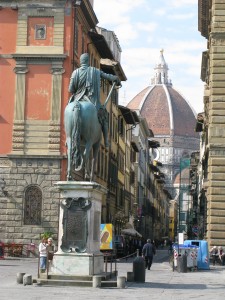In Lily City | By David Roderick

I went, I saw, I was conquered—by its stony cold shadows, by the sheep-like tourists flocking along the Via Ricasoli between Michelangelo’s David and Brunelleschi’s Dome. Florence: the Lily City. Firenze: that greatly-aged place that neutralized anyone (Galileo, Machiavelli, Dante), who tried to foist greatness upon it. Dante’s friend, Bernardo Canaccio, referred to it as “The Mother of Little Love.” I went and saw. There I walked on my American feet.
Why do we think we can take so much of a place like Florence (or any place, for that matter) with us? Daily I sat on my rented stoop and watched the lenses of hand-held recorders pressed to the brows of Germans and Japanese. I saw tour guides, their heels worn flat from walking backwards, turn umbrellas into beacons and prods. How many times did I sit there, licking gelato from a plastic spoon, thinking myself better than they?
Truth is, I was the city’s most foolish visitor. I went to write about it, a book of poems no less. Specifically, I thought I might write a poetic sequence about Michelangelo’s David. Somehow I believed I could turn my devotion into poems without any residue of that statue’s many attentions. (What hubris!) Michelangelo’s mastery exhausts anything I could say about it. When you enter the crowded gallery and circle around its towering polished figure, you can’t escape the flashbulbs and red carpet awe of its visitants. There’s a screen on a wall in which you can study, at any angle, a close-up pixilated representation of David’s face. (Face to face he looks more like an anxious boy than a minted man.) Forget about synthesizing feelings and words in that gallery—I couldn’t even gather the right materials.
There might be an authentic Florence, but I didn’t see it. Not only does language fail as an obstacle—the Florentines all speak English and they’re more than happy to serve you—wherever you turn there’s a false invitation. Stylish clothes stare from the shops, and rainbow displays of gelato. Roma women rattle tuna-tins, Ghanaians hawk knockoffs from blankets they’ll later sleep under.
Dante understood that our senses are the avenues of the mind. What sticks with me, what flashes synaptically a few years later, are residual things: textures and colors and qualities of light. The crumbly voices of men (I took them to be latent Communists) playing chess at the Café Giubbe Rosse, where Montale once sipped the local grind. Rat poison sprinkled like baby powder around certain buildings. Buzzing Vespas. In January and February: sunlight so rare I felt pistol-whipped by it. One more impressionable delight for a history punk like me: the closet latrines in the Pitti Palace, replete with slit windows through which squatting princes of the past had a pencil-thin view over a dominion.
There is one specific moment I’ll never gather in, that feels like something I might regard as transformational. While standing outside the little corner grocery, gearing up to collect everything I needed on my list so that I wouldn’t have to elbow back against the pedestrian flow, I suddenly didn’t feel like myself anymore. Frozen on that corner I realized I was just a creature on a vast planet, nothing but a bloodstream, two eyes, a set of toes.
Of course I have gauzy flashback imprints of the city’s art: Botticelli’s Venus, some manic wooden sculptures by Donatello, Fra Angelico’s frescoes, which struck me as a precursor to television. I recall hazy visions of Hell painted along stairs spiraling the inner shell of Bruno’s Dome. I remember, cast from the garden, Masaccio’s wailing Adam and Eve. But for me, none of these works rivals the apse in the Old Sacristy at the Basilica of St. Lawrence. I like to think it makes nobody’s Top Ten but mine. Frescoed in watery turquoise and blue, its quadrants limned in gold, it illustrates a symbolic and astronomically accurate representation of the Florentine sky, dated July 4, 1442. In Lives of the Artists, Vasari attributes the work to a minor painter, Pesello, whose unique contribution to Renaissance painting was the attention and care he brought to depicting animals. To that zodiac I try to return almost daily. Dozens of times I’ve failed to write poems about it. But that hardly matters. What matters is that even in a city like Florence, which constantly buries and excavates itself, you can adjust your scale of values. Under Pesello’s sky filled with animals, the apse was quiet and dustless around me. It was the only spot in Florence where I felt I was the only one there.
*
NER Digital is a creative writing series for the web. David Roderick’s first book, Blue Colonial, won the APR/Honickman Prize. Recently his poems have appeared in Poetry, NER (32.1; 24.2), Southern Review, Orion, and Shenandoah. In 2007 he was awarded the Amy Lowell Travelling Scholarship. He currently teaches in the MFA Writing Program at the University of North Carolina at Greensboro. Read David Roderick’s NER poem “Riparian.”